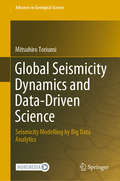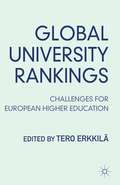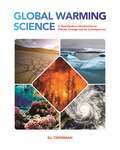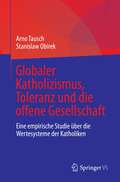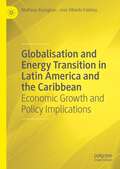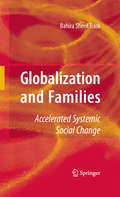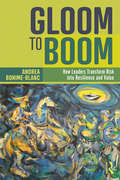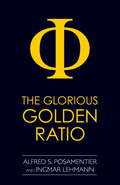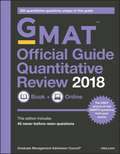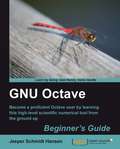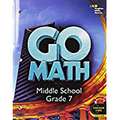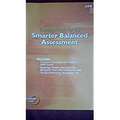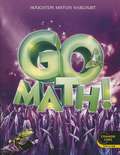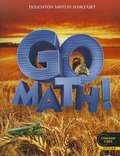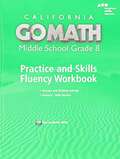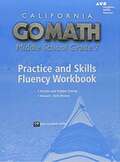- Table View
- List View
The Global Prehistory of Human Migration
by Immanuel NessPreviously published as the first volume of The Encyclopedia of Global Human Migration, this work is devoted exclusively to prehistoric migration, covering all periods and places from the first hominin migrations out of Africa through the end of prehistory. Presents interdisciplinary coverage of this topic, including scholarship from the fields of archaeology, anthropology, genetics, biology, linguistics, and more Includes contributions from a diverse international team of authors, representing 17 countries and a variety of disciplines Divided into two sections, covering the Pleistocene and Holocene; each section examines human migration through chapters that focus on different regional and disciplinary lenses
Global Seismicity Dynamics and Data-Driven Science: Seismicity Modelling by Big Data Analytics (Advances in Geological Science)
by Mitsuhiro ToriumiThe recent explosion of global and regional seismicity data in the world requires new methods of investigation of microseismicity and development of their modelling to understand the nature of whole earth mechanics. In this book, the author proposes a powerful tool to reveal the characteristic features of global and regional microseismicity big data accumulated in the databases of the world. The method proposed in this monograph is based on (1) transformation of stored big data to seismicity density data archives, (2) linear transformation of microseismicity density data matrixes to correlated seismicity matrixes by means of the singular value decomposition method, (3) time series analyses of globally and regionally correlated seismicity rates, and (4) the minimal non-linear equations approximation of their correlated seismicity rate dynamics. Minimal non-linear modelling is the manifestation for strongly correlated seismicity time series controlled by Langevin-type stochastic dynamic equations involving deterministic terms and random Gaussian noises. A deterministic term is composed minimally with correlated seismicity rate vectors of a linear term and of a term with a third exponent. Thus, the dynamics of correlated seismicity in the world contains linearly changing stable nodes and rapid transitions between them with transient states. This book contains discussions of future possibilities of stochastic extrapolations of global and regional seismicity in order to reduce earthquake disasters worldwide. The dataset files are available online and can be downloaded at springer.com.
Global University Rankings: Challenges for European Higher Education
by Tero ErkkiläGlobal University Rankings explores the novel topic of global university rankings and their effects on higher education in Europe. The contributions in this volume outline different discourses on global university rankings and explore the related changes concerning European higher education policies, disciplinary traditions and higher education institutions. The first global university rankings were published less than a decade ago, but these policy instruments have become highly influential in shaping the approaches and institutional realities of higher education. The rankings have portrayed European academic institutions in a varying light. There is intense reflexivity over the figures, leading to ideational changes and institutional adaptation that take surprisingly similar forms in different European countries. The contributions in this book critically assess global university rankings as a policy discourse that would seem to be instrumental to higher education reform throughout Europe.
Global Warming Science: A Quantitative Introduction to Climate Change and Its Consequences
by Eli TzipermanA quantitative, broad, hands-on introduction to the cutting-edge science of global warmingThis textbook introduces undergraduates to the concepts and methods of global warming science, covering topics that they encounter in the news, ranging from the greenhouse effect and warming to ocean acidification, hurricanes, extreme precipitation, droughts, heat waves, forest fires, the cryosphere, and more. This book explains each of the issues based on basic statistical analysis, simple ordinary differential equations, or elementary chemical reactions. Each chapter explains the mechanisms behind an observed or anticipated change in the climate system and demonstrates the tools used to understand and predict them. Proven in the classroom, Global Warming Science also includes “workshops” with every chapter, each based on a Jupyter Python notebook and an accompanying small data set, with supplementary online materials and slides for instructors. The workshop can be used as an interactive learning element in class and as a homework assignment.Provides a clear, broad, quantitative yet accessible approach to the science of global warmingEngages students in the analysis of climate data and models, examining predictions, and dealing with uncertaintyFeatures workshops with each chapter that enhance learning through hands-on engagementComes with supplementary online slides, code, and data filesRequires only elementary undergraduate-level calculus and basic statistics; no prior coursework in science is assumedSolutions manual available (only to instructors)
Globaler Katholizismus, Toleranz und die offene Gesellschaft: Eine empirische Studie über die Wertesysteme der Katholiken
by Arno Tausch Stanislaw ObirekDieses Buch bewertet systematisch die politischen und sozialen Werte der mehr als 1,3 Milliarden Katholiken auf der ganzen Welt, der bei weitem größten Konfession des westlichen Christentums. Auf der Grundlage einer umfassenden Analyse von Daten aus dem World Values Survey und anderen globalen Meinungsumfragen wirft das Buch ein neues Licht auf die Wertesysteme und Meinungen der Katholiken. Die Autoren heben zentrale Probleme und Herausforderungen hervor, mit denen die Kirche derzeit bei der Anpassung an die moderne Welt konfrontiert ist, einschließlich des katholischen Antisemitismus, der religiösen und sexuellen Toleranz und der Meinungen zur Demokratie, und bieten gleichzeitig eine anthropologische Reflexion darüber, wie gut sich die Kirche an die Anforderungen einer offenen Gesellschaft anpasst oder nicht.
Globalisation and Energy Transition in Latin America and the Caribbean: Economic Growth and Policy Implications
by Matheus Koengkan José Alberto FuinhasThis book explores the potential for renewable energy development and the adoption of sustainable production processes in Latin America and the Caribbean. By examining the energy transition process, the impact of environmental degradation, and the relationship between renewable energy sources and economic growth, the effects of increased globalisation and liberalisation in this part of the world are analysed. Particular attention is given to renewable energy investment, the energy-economics growth nexus, the impact of trade openness, and the mitigation of carbon emissions. This book aims to highlight econometric techniques that can be used to tackle issues relating to globalisation, the energy transition, and environmental degradation. It will be relevant to researchers and policymakers interested in energy and environmental economics.
Globalisation, Economic Inclusion and African Workers: Making the Right Connections
by Kate Meagher Laura Mann Maxim BoltThis book addresses the question of whether greater inclusion in the global economy offers a solution to rising unemployment and poverty in contemporary Africa. The authors trace the connection between global demographic change and new mechanisms of economic inclusion via global value chains, digital networks, labour migration, and corporate engagement with the bottom of the pyramid, challenging the claim that African workers have become functionally irrelevant to the global economy. They expose the shift of global demand for African workers from formal to increasingly informalised labour arrangements, mediated by social enterprises, labour brokers, graduate entrepreneurs and grassroots associations. Focusing on global employment connections initiated from above and from below, the authors examine whether global labour linkages increase or reduce problems of vulnerable and unstable working conditions within African countries, and considers the economic and political conditions needed for African workers to capture the gains of inclusion in the global economy. This book was previously published as a special issue of the Journal of Development Studies.
Globalization and Families
by Bahira TraskAs our world becomes increasingly interconnected through economic integration, technology, communication, and political transformation, the sphere of the family is a fundamental arena where globalizing processes become realized. For most individuals, family in whatever configuration, still remains the primary arrangement that meets certain social, emotional, and economic needs. It is within families that decisions about work, care, movement, and identity are negotiated, contested, and resolved. Globalization has profound implications for how families assess the choices and challenges that accompany this process. Families are integrated into the global economy through formal and informal work, through production and consumption, and through their relationship with nation-states. Moreover, ever growing communication and information technologies allow families and individuals to have access to others in an unprecedented manner. These relationships are accompanied by new conceptualizations of appropriate lifestyles, identities, and ideologies even among those who may never be able to access them. Despite a general acknowledgement of the complexities and social significance inherent in globalization, most analyses remain top-down, focused on the global economy, corporate strategies, and political streams. This limited perspective on globalization has had profound implications for understanding social life. The impact of globalization on gender ideologies, work-family relationships, conceptualizations of children, youth, and the elderly have been virtually absent in mainstream approaches, creating false impressions that dichotomize globalization as a separate process from the social order. Moreover, most approaches to globalization and social phenomena emphasize the Western experience. These inaccurate assumptions have profound implications for families, and for the globalization process itself. In order to create and implement programs and policies that can harness globalization for the good of mankind, and that could reverse some of the deleterious effects that have affected the world's most vulnerable populations, we need to make the interplay between globalization and families a primary focus.
Gloom to Boom: How Leaders Transform Risk into Resilience and Value
by Andrea Bonime-BlancLeaders – whether in business, government or the nonprofit sector – take risks but often without fully understanding risk at a strategic level. Expanding upon the well-known "ESG" risks, this book explains the key nonfinancial (environmental, social, governance and technological or ESGT) risks. For many leaders (including board members), taking risk without knowledge or preparation can lead to organizational crisis, scandal and value destruction. For those who are prepared, resilience follows and so does the ability to transform ESGT risk into opportunity and value for stakeholders. In this book, global governance, risk, ethics and cyber strategist, author and board member, Andrea Bonime-Blanc, shows practitioners at all levels how to effectively identify and manage their top ESGT risks to avoid crises and transform risk into sustainable long-term resilience and value. Gloom to Boom is a book for everyone – from the highest levels of leadership in an organization (the board, CEO and C-suite), to other senior leaders (the chief risk officer, CFO, general counsel, head of CSR and sustainability, CISO, CHRO), and midlevel leaders, students and folks simply interested in current affairs and the role and impact of strategic risk and opportunity on their lives.
The Glorious Golden Ratio
by Alfred S. PosamentierWhat exactly is the Golden Ratio? How was it discovered? Where is it found? These questions and more are thoroughly explained in this engaging tour of one of mathematics' most interesting phenomena. Veteran educators and prolific mathematics writers trace the appearance of the Golden Ratio throughout history and demonstrate a variety of ingenious techniques used to construct it and illustrate the many surprising geometric figures in which the Golden Ratio is embedded. Requiring no more than an elementary knowledge of geometry and algebra, the authors give readers a new appreciation of the indispensable qualities and inherent beauty of mathematics.
GMAT Official Guide Quantitative Review 2018
by Graduate Management Admission CouncilThe GMAT Official Guide Quantitative Review provides targeted preparation for the mathematical portion of the GMAT exam. Designed by the Graduate Management Admission Council, this guide contains 300 real GMAT questions from past exams including 45 never-before-seen questions, plus the following features: <p><p> - An overview of the exam to help you get familiar with the content and format <p> - Review essential algebra, geometry, arithmetic, and word problems <p> - Detailed answer explanations that explain how the test maker thinks about a question <p> - Questions organized in order of difficulty from easiest to hardest <p> - Access to the same questions online at gmat.wiley.com, where you can build your own practice sets <p> Don’t waste time practicing on fake GMAT questions. Optimize your study time with the GMAT Official Guide 2018 Quantitative Review using real questions from actual past exams.
GNU Octave Beginner's Guide
by Jesper Schmidt HansenThis is a practical, step-by-step guide that will help you to quickly become a proficient Octave user. The book is packed with clear examples, screenshots, and code to carry out your data analysis without any problems.This book is intended for anyone interested in scientific computing and data analysis. The reader should have a good level of mathematics and a basic understanding of programming will be useful, although it is not a prerequisite.
Go Math!: Student Interactive Worktext (Grade #6)
by Edward B. Burger Juli K. Dixon Timothy D. KanoldGo Math: Middle School, Grade 7
by Edward B. Burger Juli K. Dixon Timothy D. Kanold Matthew R. Larson Steven J. Leinwand Martha E. Sandoval-MartinezThis textbook for 7th graders covers essential math topics, with study guide reviews and assessments.
GO Math!: Getting Ready for the Smarter Balanced Assessment (Grade #5)
by Houghton Mifflin HarcourtCommon Core Assessment consortia have developed assessments that contain item types beyond the traditional multiple-choice format. This allows for a more robust assessment of students' understanding of concepts. Common Core assessments will be administered via computers; and Getting Ready for the Smarter Balanced Assessment presents items in formats similar to what you will see on the tests.
Go Math!: Student Interactive Worktext (Grade #8)
by Houghton Mifflin HarcourtGo Math!: Student Interactive Worktext (Grade 8)
Go Math!: Insuccess Student Edition Grade 4 (Gomath! Ser.)
by Houghton Mifflin Harcourt*This textbook has been transcribed in UEB, formatted according to Braille textbook formats, proofread and corrected. <P><P>
GO Math!: Student Edition, Grade 3 (GO Math! Ser.)
by Houghton Mifflin Harcourt StaffCommon Core Assessment consortia have developed assessments that contain item types beyond the traditional multiple-choice format. This allows for a more robust assessment of students' understanding of concepts. Common Core assessments will be administered via computers; and Getting Ready for the Smarter Balanced Assessment presents items in formats similar to what you will see on the tests. The following information is provided to help familiarize you with these different types of items. Each item type is identified on pages (vii-viii). The examples will introduce you to the item types. The following explanations are provided to guide you in answering the questions. These pages describe the most common item types. You may find other types on some tests.
Go Math!: Student Interactive Worktext Grade 8 2014 (Go Math! Ser.)
by Holt McdougalGo Math!: Student Interactive Worktext Grade 8
Go Math!: Practice Fluency Workbook Grade 8 (Go Math! Series)
by Holt McDougalMath instruction is always evolving, with new approaches to pedagogy, engagement, and technology. GO Math!® meets students and teachers on their math journey, raising student achievement scores and supporting teachers along the way. <p><p> Designed by the same author team across K–8, GO Math! incorporates the latest thinking in its comprehensive approach and engages digital natives with cross-platform technology. It helps teachers to differentiate instruction, building and reinforcing foundational math skills that translate from the classroom to real life.
Go Math!: Practice Fluency Workbook Grade 7 (Go Math! Series)
by Holt McDougalath instruction is always evolving, with new approaches to pedagogy, engagement, and technology. GO Math!® meets students and teachers on their math journey, raising student achievement scores and supporting teachers along the way. <p><p> Designed by the same author team across K–8, GO Math! incorporates the latest thinking in its comprehensive approach and engages digital natives with cross-platform technology. It helps teachers to differentiate instruction, building and reinforcing foundational math skills that translate from the classroom to real life.
Go Math!: Student Interactive Worktext, Grade 7
by Houghton StaffHMH Go Math!: Student Interactive Worktext, Grade 7, 2018 Common Core Edition

